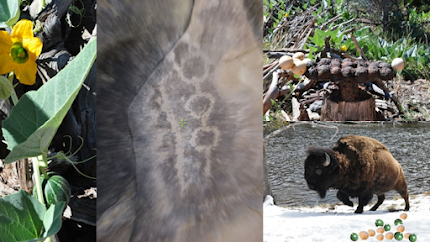Buffalo Gourds; A Fresh Look at an Ancient Plant
If one sees a metate and the mono that goes with
it, it is possibly 12,000 years old (plus the millions of years of age of the
stone itself), give or take a few millennia.
If it was carried from Beringia (the strip of land that once connected
Asia and what’s now Alaska), which is a colorfully absurd thought then it might
be 25,000 years old because the Beringians lived there, possibly, for 10,000
years; waiting for the ice to melt and forcing them to mosey down to The Land
of Enchantment, perhaps looking for and finding ‘greener pastures’. As they did not yet invent fry bread or even
have white or whole wheat flour (as the major grains were brought over by the
Europeans by way of the Steppes) and corn was still in South America, then the
question becomes: what did they eat?
And, especially, as the centuries wore on and droughts came and went,
leaving ancient tree rings proving drought; what did they rely on during those
times? The piñon bumper harvest happens
every now and then, so one can’t wait for that, really. Amaranth wasn’t even around. There were lots of grasses and because of
that there were lots of ‘bison’, or what I think of as ‘buffalo”. So there was meat. What about tubers and seeds? They had a metate and needed something to
grind up with it. I honestly (this time)
think it was what scientists call Cucurbita foetidissima or Buffalo Gourd, the
common name that mysteriously first appeared in print in 1948 and took.
I have
seen my donkeys occasionally eat the ‘disgusting smelling’ leaves (and then
walk up to me and exhale on me, almost rendering me unconscious), so they and
just a handful of people sort of like the smell; nonetheless it is called,
roughly translated from the Latin, ‘stinking squash’. Well, lots of plants are named ‘stinking’
this and ‘stinking ‘ that but some
observant person(s) decided on ‘Buffalo Gourds’; a very powerful thing like a buffalo (…… I am
not sure but curious about what a buffalo smells like….aren’t you?) and as the
bison tended to roll around on the ground and on their backs and make huge
semi-permanent ‘wallows’ of bare ground that, fascinatingly, almost nothing
grows on after they are done….except, let’s say, the buffalo gourd which has a
huge tuber for a root; sometimes the size and shape! of a human being and is very capable of surviving almost anything,
and I am wondering if, by chance, buffalos liked to roll in the stinking leaves
for the special insect and fly repelling properties (one of the uses people are
looking into as I write) and maybe the side benefit of it being a cow
aphrodisiac or medication (think ‘zoopharmacology’; not my term but perhaps
coined by my brother!); they grew on
afterwards, and as the gourds have a distinct resemblance to a bull buffalo
piece of anatomy anyway and so some
observant person(s) back in the day decided to call this amazing plant “buffalo
gourd”!
I recently
encountered a petroglyph that puzzled me until I ‘realized’ that I probably
knew what it was:
The triangle shapes on the left side of the
‘gourd’ circles are the basic shape of the leaves; in fact the rock art
clearly, in my mind, celebrates buffalo gourds….and why shouldn’t it because it
was a main staple of the native diet; the seeds and hull ground up by the
metate into a fine flour to make a tasty sun-baked-on-the back-of-a-rock (or
metate) flat bread!
The point is that the buffalo gourd plant, what
with its high protein/oil seeds, huge tuber, extreme drought tolerance, insect
repellent and medicinal properties and its myriad other colorful aspects ( and
great for batting practice!); I bet a
nickel it’ll save the world!


No comments:
Post a Comment
I think I solved the comments issues that were troublesome; please let me know; ts